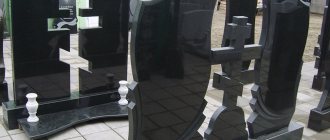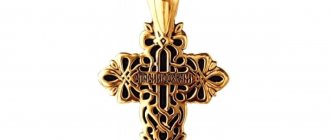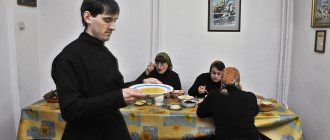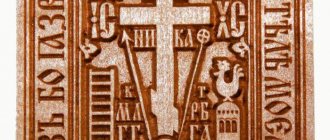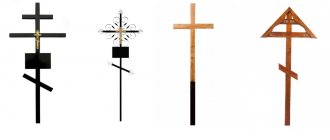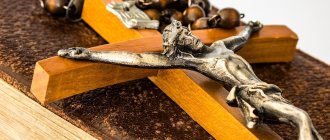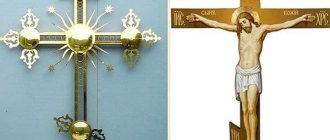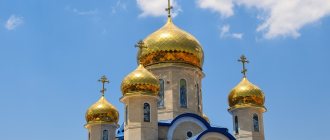In ancient times, when someone went to distant countries, for example with a trade caravan, he left a special sign at home so that his family could recognize his messenger. To do this, they took a board and broke it into two halves. One remained at home, and the traveler took the other with him so that when he needed additional money or goods from home, he could send a messenger with this tablet.
Households, having aligned the uneven edges of the scrap and, making sure that this was really the original half of their board (all the notches matched), could entrust the messenger with money or transfer things, goods for delivery to a distant country, without doubting that the messenger came from their loved one. This tablet was called the “symbol”.
Useful materials
The symbol in Greek “σύμβολον” is a conventional sign, i.e. reflection of some meaning, idea or concept, designation of something, expression of the invisible in the visible. The cipher, the password, is a continuation of the same theme, only the password is for two, and everyone can know the symbol and understand the same thing by it.
Symbols are present in all areas of our lives, for example, the coat of arms and flag of the state. We see a certain image and understand which country is represented by it. A white wedding dress and veil are a symbol of the bride’s purity (and it’s funny when a veil is worn when getting married for the third time). That is, behind certain signs - symbols there are meanings that are understood by everyone. So, in everyone’s understanding, the Cross symbolizes Christianity, because it is associated with Christ and His death on the cross. This is for everyone. For Christians themselves, the Cross has a special, unearthly meaning, being a symbol of the future Resurrection.
Worship cross of the 18th century. Perm wooden sculpture 1985: XVII century. Vlasova O. M. 2003: XVIII century. Perm wooden sculpture 2013: Last quarter of the 18th century. 170.5 × 112 × 8 cm Perm State Art Gallery, Perm, Russia Inv. DS-5 From the Church of the Holy Trinity in the village of Vilgort, Cherdyn region.
History of veneration in Orthodoxy
The Orthodox Church teaches its children to venerate the Cross, because on the Cross the great Mystery of our redemption was accomplished: “You bore our sins in Your body on the tree” (1 Pet. 2:24). The Lord Himself chose it as a weapon of His victory over death and a saving sign for us:
“I give My life, (...) No one takes it from Me, but I myself give it. I have authority to lay it down, and I have authority to receive it again” (John 10:17-18).
The Lord knew not only about death, but also about the method of execution:
“And as Moses lifted up the serpent in the wilderness, so must the Son of Man be lifted up” (John 3:14).
He warned his disciples about all this:
“And He called back His twelve disciples, and said to them, “Behold, we are going up to Jerusalem, and all that is written through the prophets concerning the Son of Man will be fulfilled, for they will hand Him over to the Gentiles, and they will mock Him, and insult Him, and spit on Him, and they will beat Him, and they will kill Him: and on the third day He will rise again. But they didn't understand any of this; these words were hidden to them, and they did not understand what was said” (Luke 18:31-34).
Icon cross “The Crucifixion of Christ with those coming” Second half of the 19th century. Copper alloy, casting, silvering, enamel. 22.1 × 14.1 × 0.4 cm Central Museum of Ancient Russian Culture and Art named after. Andrey Rublev, Moscow, Russia
Even the disciples did not immediately comprehend what had happened; the gift of the Holy Spirit, which they received at Pentecost, enlightened them, “guiding them into all truth” (John 16:13). The apostolic sermon spread throughout the world. Believers accepted the Resurrection and bowed before the terrible and immense Sacrifice made on the Cross by God for us.
The sermon about God who died on the Cross shocked the hearts of some, while others considered these words absurd, not fitting into their “logical” picture of the world. The Apostle Paul said: “
We preach Christ crucified, a stumbling block to the Jews and foolishness to the Greeks” (1 Cor. 1:23), “For the message of the cross is foolishness to those who are perishing, but to us who are being saved it is the power of God” (1 Cor. 1:18).
It is impossible to talk about the Cross to non-believers; to explain the Mystery of the Cross with human wisdom is a futile effort, say the Fathers of the Church. The pagans laugh at the Cross; the Jews did not accept Christ, who humbled himself to death on the cross. Saint Theophan the Recluse (†1894) shows how he attracts his own by the word about the Cross, choosing from among the perishing, using a simple example:
“It’s all the same, as if you point a magnet at particles of different metals, the magnet will choose from all of them and attract iron particles to itself... which are from the truth, they themselves turn to it and adhere to it.”
The Apostolic word about the Cross became a magnet that called the faithful to follow Christ on the way of the cross:
“If anyone wants to come after Me, let him deny himself, and take up his cross, and follow Me” (Mark 8:34).
Having believed and loved Christ, the faithful also loved His Cross.
The veneration of the Cross as a symbol of Life began with the first Christian communities. According to the testimony of the early Christian writer Tertullian (†220), the veneration of the Cross began in the 1st century, from the very beginning of the existence of the Church. Already the first Christians, as a sign of respect, carried with them the image of the Cross, some even depicted the Cross on their foreheads, which made them the first to suffer during persecution.
And yet, in the beginning, the veneration of the Cross was mostly secret, hidden from the pagan environment. In the Roman catacombs of the 2nd and 3rd centuries, the first hidden drawings of a cross were found in the form of the Greek letter T "tau" or in the form of the letter X. Sometimes in the drawings the first letters of the name of Jesus Christ were combined (I and X), which constituted a special allegorical image of the Cross, it happened , that this image was additionally decorated with floral ornaments, which seemed to shade and cover the Cross and, at the same time, was a symbol of the flourishing Cross, which bore good Fruit.
The first Christians placed a symbolic image of the Cross on the walls of their houses, on the vaults of tombs, and wove belts with the sign of the Cross to wear on themselves. We know that the first centuries were marked by persecution of Christians, so showing the sign of the Cross on oneself meant being a confessor. Cases of confessional wearing of the Cross on oneself were noted in acts of martyrdom; these were such confessors as the martyr Procopius (†303), who suffered under Diocletian, openly wearing a cross around his neck, or the warrior martyr Orestes (†304).
The full veneration of the Cross among Christians began after the adoption of the Edict of Milan in 313. The liberation of Christians from cruel persecution and a new attitude towards the Christian faith in the state is associated with the names of the holy Equal-to-the-Apostles Emperor Constantine (†337) and his pious mother Queen Helena (†330), who worked hard to find the Life-giving Cross of the Lord at the site of Christ’s execution in Jerusalem and found it in 326. For these works and her faith, the Holy Church calls Queen Helen, as well as her son, equal to the apostles.
The newly opened freedom of religion of Christ spread the custom of the sign of the cross everywhere:
“Let us not be ashamed to confess the Crucified One, let us boldly depict with our hands the “sign of the cross” on our foreheads and on everything: on the bread that we eat; on the cups from which we drink, and depict him when going out; when we go to bed and get up, when we are on the road and rest. He is a great protection given to the poor as a gift and to the weak without difficulty.”
- says Saint Cyril of Jerusalem (†386).
John Chrysostom (†407), Archbishop of Constantinople adds:
“If you feel that your heart is irritated, protect your chest with the sign of the cross.” And also, calling on Christian mothers not to desecrate the bodies of their children with amulets, he also says: “You should not place anything on babies except the saving cross!”
That is, by this time everyone, even children, wears crosses.
Since the mid-thirties of the 4th century, the tradition of celebrating the day of the Exaltation of the Holy Cross has been established in Jerusalem. The day of raising the Holy Cross by Queen Helena is considered to be September 14, 326. The consecration of two churches at the site of the discovery of the Cross and at the site of the Resurrection of Christ was also timed to coincide with this day, and this common holiday was then called the Day of Renewal, and was celebrated solemnly.
Ermiy Sozomen (†450), author of “Ecclesiastical History,” wrote:
“The Jerusalem Church celebrates this holiday annually and very solemnly, so that then even the sacrament of baptism is taught and church meetings last 8 days; On the occasion of this celebration, people flock there to visit St. places, many from almost the entire sunflower industry.”
On the day of this holiday in honor of the Holy Cross, the once Egyptian girl Mary came to Jerusalem and here she was called by the Lord to repentance, which changed her whole life and gave Saint Mary of Egypt to the world.
Although at first this celebration was more local in nature, yet, coming to Jerusalem for the holiday, pilgrims spread the tradition of celebrating the Exaltation of the Cross to their countries. The Exaltation of the Cross was especially revered in the eastern churches; in the West, the celebration of the Cross begins with the return of the Venerable Tree of the Cross of the Lord from Persian captivity in the 7th century.
The very tree of the Cross of Christ is revered by Christians as a life-giving shrine, because the Blood of the Savior was poured onto it. Particles of the tree of the Holy Cross are distributed among churches in different parts of the world, are placed in precious frames and are revered by believers as the most precious shrines.
By this time, special services were already being held in churches everywhere in honor of the Cross of the Lord. Church historians point to the antiquity of the hymns to the Exaltation of the Cross that have been preserved and are still used during services. For example, the texts of the troparia “To Thy Cross” and “Save, Lord” date back to the 6th or even 5th century.
The veneration of the Cross is expressed in church services, in solemn Holidays dedicated to the Cross: September 27 (new century) - the Feast of the Universal Exaltation of the Life-Giving Cross of the Lord, one of the twelve great Holidays of the Church and the only one of them dedicated to an event after the Gospel story.
The Cross is also honored in the third week of Great Lent, called the Veneration of the Cross, when the Cross is brought to the center of all churches for the worship of believers.
Everyone knows and loves the holiday of the Origin (destruction) of the Honest Trees of the Life-Giving Cross of the Lord (August 14), popularly called the Honey Savior.
May 7 (May 20 New Art.) - Remembrance of the appearance in heaven of the Cross of the Lord in Jerusalem (351).
In addition, every Wednesday and Friday in the weekly daily cycle of services is dedicated to the Cross of the Lord.
Temples and churches are decorated with crosses.
The cross is a symbol of love for the Savior Lord Jesus Christ and faith in Him. Christians put on the cross in the Sacrament of Baptism and carry it on themselves throughout their lives. For believers, this is a shrine and protection from an ancient enemy.
As Saint Gregory the Theologian says (†389):
“Get away, devil, or I will overthrow you with the cross, before which everything trembles. I carry the cross in my limbs, the cross in my procession; cross in my heart; the cross is my glory."
At the Ecumenical Councils, the holy rules of veneration of the Cross of the Lord as well as holy icons were approved. The Sixth Ecumenical Council (680) in canon 73 declared:
“If the Cross is written on the ground, let it be blotted out,” i.e. He commanded to blot out the holy image if the Cross is inscribed on the ground, to raise it if it is placed on the floor, so that no one, neither animals nor humans, tramples the victorious weapon of Christ with their feet. That is, we must treat the Cross as a shrine, no matter where and in what form it is depicted.
To this rule, in the book “Stone of Faith” by Metropolitan Stefan (Yavorsky) (†1722), a story from Kormcha is given:
“Caesar Tiberius (not the one who was at the time of Christ, he was an idolater, but another pious Caesar, after Constantine the Great), once walking around his royal chamber, saw on the ground a Cross carved in marble, and immediately ordered it to be taken away, saying that if the Cross of the Lord should be depicted on the forehead and chest, then how dare we trample it underfoot. When they removed the marble stone on which the Cross was inscribed, a treasure of more than one hundred thousand gold pieces was discovered, as if in reward for the cross-loving king for his piety.”
Neck cross Manufacturing center: Staritsa XIV–XVI centuries. Copper alloy, casting. 4.2 × 2.5 × 0.4 cm Central Museum of Ancient Russian Culture and Art named after. Andrey Rublev, Moscow, Russia
The unusualness of an ordinary cross
Wanda : But an ordinary cross, what should we know about it?
Alena : There is such information that two sticks that intersect, we have this sign with a fixed image everywhere. But these sticks can be moved to create or change something.
This is how the types of crosses known to mankind change. And here you need to be careful, since one cross can mean the beginning, and the other can completely stop the processes.
Often, extra elements, some intersecting lines and other elements are added to the true cross, which distort the correct sound of the cross. When you turn to the cross, you turn to the Creator of all things.
Wanda : Correct and I understand that the cross is connected with Higher Powers?
Alena : Yes, exactly. The cross is associated with the Higher Powers. Communication with Higher Powers is associated with the movement of these two intersecting elements. You can change the angle of inclination of these intersecting elements and thereby send and receive information.
There is a teaching on Earth related to the number "17", there is a true understanding of this symbol and its functionality. The Higher Powers already hear us, but manipulation with the cross helps us reach different fields and levels.
Wanda : Let's find out more about the number “17”. Why was this particular number mentioned and what is connected with it?
Alena : Here we need to figure out this number, they don’t give me a direct answer. They say take a closer look at this number, this is a code for something. If someone can unravel this information, they will be able to enter that space.
Meaning
According to Saint Maximus the Confessor (†662
.) “the whole spiritual world is mysteriously represented in symbolic images in the sensory world for those who have eyes to see, and the whole sensory world is contained in the spiritual world.”
The symbolism of the Cross has a history.
Man's knowledge of the mysterious sign of the cross extends back to the most ancient times; it has always been with man. For example, a cross in a circle is known to many ancient cultures as an image symbolizing light or fire (fire was made using sticks folded in a cross).
The cross was also understood as the unity of time and space - the crosshairs of the vertical and horizontal, i.e. the connection of everything is the center of life. The ancient Egyptian symbol - the key of life (ankh) is very similar to the cross. This ancient symbolism of the cross as the center or key of life was fully embodied in the New Testament through the crucifixion and Resurrection of Christ.
The Cross embraces everything, stretching to all ends - the most unattainable heavenly height and the very depth of suffering, throughout the entire space of the universe and for all times, imprinted on the entire Creation of God.
“Just as the four ends of the Cross are connected and united in the center, so the height, and depth, and longitude, and breadth, that is, all visible and invisible creation, are contained by God’s power.”
, says the Monk John of Damascus (†about 780).
The cross was an instrument of salvation according to the teachings of Gregory Palamas (†1359) even before Golgotha. Even in Old History, there are prototypes of the Cross everywhere: in the cross-shaped stacking of firewood on the shoulders of Isaac, who ascends the mountain to become a sacrifice (Gen. 22), in the symbolic crossing of hands when Jacob blessed the sons of Joseph (Gen. 48). Moses inscribed it on the waters of the Red Sea with his rod in order to translate the people, first dividing and then uniting the water (Ex. 14). The prototype of the Cross of Christ and the tree that sweetened the bitter waters of Marah (Exodus 15), and the serpent lifted up on the tree (Numbers 21) and many other images of the Old Testament.
The Crucifixion terrified Jews and non-believers. They saw in it only a terrible instrument of cruel and shameful execution, which was not used by the Jews. They remembered that the Law said, “Cursed is everyone who hangs on a tree” (Deut. 21:23).
But not all of them wanted to hear the apostle: “Christ has redeemed us from the curse of the law, having become a curse for us” (Gal. 3:13). Because “not everyone who hangs on a tree is cursed before God, but he who has sinned a sin worthy of death,” says Blessed Jerome (†420) to everyone.
The law prescribed the punishment of sin, but God is sinless. And Saint John Chrysostom (†407) confirms:
“Whoever wants to destroy an oath must himself be free from the oath, must take upon himself an undeserved oath - instead of a deserved one: Christ took such an oath upon Himself and with it destroyed the deserved one.”
The sinless One, having died for sinners, frees them from death. In spiritual blindness, people also forgot the prophecy of the great leader Moses: “your life will hang before you” (Deut. 28:66).
Even now, non-believers cannot understand how Christians carry the instrument of execution on themselves. Once, when asked to cross himself when entering a church, one “parishioner” answered me: “I’m not going to put a cross on myself.” Who is so afraid of the Cross? Cyril, Saint of Jerusalem (†386), explains:
“For this is the grace of God; a sign for the faithful and fear for evil spirits. Because through the Cross He conquered them, sovereignly putting them to shame (Col. 2:15). When they see the Cross, they remember the Crucified One. They are afraid of the dragon who crushed the head. Do not neglect this sign for the reason that it was given to you freely, but for this, honor the Benefactor all the more.”
The power of the Cross is great; the believer becomes convinced of it through experience and learns to always support his life with the sign of the cross, wearing and venerating the Cross of the Lord.
“The cross is a trophy against demons, a weapon against sin, the sword with which Christ pierced the serpent,”
- says John Chrysostom († 407) and compares the Cross to a lamp for the whole world.
The main symbolism of the Cross for every Christian should be the feat of following Christ and bearing one’s cross. Without humility before Him in your weaknesses, without assimilating His sacrificial love, without belittling yourself for the sake of Christ and your neighbor, without imitating Him in meekness and love for people, without crucifixion of your passions, without renouncing proud self-confidence, without patience in sorrows and illnesses, Without fulfilling His will, it is impossible to be His disciple. But how light is the cross with Him:
“Come to me, all you who labor and are heavy laden, and I will give you rest: take my yoke upon you, and learn from me, for I am meek and lowly in heart: and you will find rest for your souls: for my yoke is easy, and my burden is light” (Matthew .11:28-30).
Forms
Various forms of the cross are known and have always been used by Christians:
- T (tau), or so-called Egyptian cross (ankh).
- The shape of the anchor is as a symbol of aspiration to the desired harbor - Eternal Life.
- Monogrammed - a combination of the first letters of the name of Jesus Christ - I and X. This form is developed into the monogram of Constantine with the combination of I and P - the cross that he saw in the sky with the words “hereby conquer!” The letter P means "King", in Roman "Rex". The appearance of this monogram was diversified by the introduction of a central letter in the form of a staff - the so-called. pastoral, or changing it into a trident, like a tool of the fisherman-apostle - “fisher of men.”
- “The vine” is the blossoming cross “I am the vine, and you are the branches” (John 15:5).
- Greek four-pointed cross, so-called. "kite".
- Cross-dome with a crescent.
The crescent shape confuses some people as to why the Orthodox symbol is placed above the Islamic symbol. But there is no connection with Islam. The crescent here turns the cross into an anchor - a symbol of hope, which has already been said or can be represented like this: salvation - The Cross of Jesus comes from
“A woman clothed with the sun, under whose feet is the moon, and on whose head is a crown of twelve stars” (Rev. 12:1).
Christ is the Sun of Truth, dissolving our night and conquering the darkness of sin and ignorance. Initially, the Cross was just a cross, without the Crucifix, which began to spread in churches only from the 7th century. The first known forms of the cross were four-pointed, differing only in proportion:
- both crossbars are the same - “Latin”,
- vertical is longer than horizontal - “Greek”.
Saint Irenaeus of Lyons (†202) and Blessed Augustine (†430) testify to the four-pointed Calvary Cross.
The Church allowed the variety of forms of the Cross; the saints believed that the grace-filled power of the Cross does not depend on the form, only on our faith.
“The cross of any form is the true cross,” said the Rev. Theodore the Studite († 826). “And not by the number of trees, not by the number of ends, the Cross of Christ is revered by us, but by Christ Himself, whose most holy blood was stained,” says Saint Dmitry of Rostov (†1709), and adds: “displaying miraculous power, any cross does not act by itself, but by the power of Christ crucified on him and by invoking His most holy name.”
However, different Churches have adopted and traditionally used their own forms. The Russian Orthodox cross is a six- or eight-pointed form of the cross. Eight-pointed - a crucifix with a foot and an additional upper bar - a tablet installed by Pilate indicating the guilt:
“Pilate also wrote the inscription and placed it on the cross. It was written: Jesus of Nazareth, King of the Jews” (John 19:19).
It was written for everyone - in Hebrew, Greek, Roman. Thus, on the upper bar of the Orthodox cross the letters are depicted: “IHCI” - “Jesus of Nazareth, King of the Jews.”
The Orthodox eight-pointed shape of the Cross retains historical accuracy. In addition, this form was doctrinal: the lower crossbar - the foot - is depicted beveled, one end is higher than the other, as a symbol of the fact that one thief crucified next to Jesus, who sincerely repented and asked for the mercy of Christ, was saved, and the other, who blasphemed Him, died .
Symbolism of the number "17"
Wanda : But, for example, such a science as numerology, or, for example, tarot, or, for example, runes - through these sciences can one come to an understanding of this numerical code?
Alena : Numerology will not give an accurate understanding. But tarot and runes provide more complete information about this code.
Wanda : Why don’t they give a full answer about this code now?
Alena : This is the key to the mystery and a person must make an effort to unravel this mystery. If there is no understanding, then you cannot move on. There is information that should not be freely available; you need to “grow up” to this information.
The number “17” is in the symbolism of yin and yang, and is in the name of the community that owns the secret of the cross. They show me a map of where exactly this society is located; according to the mark, it is the south of America.
Wanda : What energy does the cross carry?
Alena : The first answer is positive energy. We humans sometimes use this energy for bad purposes. Depending on the request, he will bring what he wants to everyone, the sick - health, the unhappy - happiness, a childless woman - a child.
Even a cross with rigidly fixed elements, it still unfolds the space. You strive for stability, you want to firmly consolidate everything, but this is not entirely true. If you even start rotating the cross, you begin to change the field around you.
But this is your cross, it can be inside you. In your body, blood vessels and arteries are built according to the principle of a cross. By unfolding that cross, you thereby harmonize everything around, and you can even heal yourself.
Wanda : Returning to the original cross, which is in the shape of an “X,” that’s what human chromosomes look like. Is this related to the information that has just been given?
Alena : Yes, this is a direct connection. If you pay attention to the chromosome, you will see more stripes, and these stripes also form an “X”. Each chromosome contains encrypted information from the Higher Powers.
The fact that we are engaged in regressions is that the soul comes with tasks and intentions here to planet Earth to gain experience, and it turns out that the appearance reflects some experience gained. Codes are built into chromosomes in such a way that we can experience receiving information through the experience of living life.
Features of the image of the Crucifixion
The image of the Crucifixion, which appeared much later, was the result of the development of the theological tradition - God incarnate and becoming a man could be depicted. But this image expressed the peculiarity of the theological views of East and West.
“By the cross of our Lord Jesus Christ, death was abolished, ancestral sin was resolved, hell was deprived of prey, the Resurrection was given, the power was given to us to despise the present and even death itself, the path to original bliss was prepared, the gates of heaven were opened, our nature was seated at the right hand of God, and we became children and heirs of God. All this was accomplished by the Cross."
, - John of Damascus (†about 780) spoke about the joy of victory.
This celebration required Christian art to depict Victory on the Cross. Until the 9th century, Christ was depicted on the Cross alive and even triumphant. Precious metals, gold, and stones were used to depict the celebration.
The deceased Christ began to be depicted only in the 10th century. In Catholic churches they began to use Crucifixes, depicting the suffering and torment of the Savior, and used naturalistic depiction techniques with muscle tension and a reflection of suffering on the face. By this naturalism one can distinguish a Catholic crucifix from an Orthodox one. The Orthodox Crucifixion is always an icon image, i.e. an image of the spiritual world, devoid of carnal characteristics and naturalness.
In addition, in the east, since ancient times, on the Crucifixion, Christ was depicted with his legs, each nailed with a separate nail. The depiction of the Savior with crossed legs, nailed with one nail, began in the West from the 13th century. Our Church has preserved the tradition of depicting Christ as Risen and embracing the whole world.
Orthodoxy invariably teaches that suffering is necessary for all sinners for their humble assimilation of the Fruit of redemption - the Holy Spirit sent by the sinless Redeemer, which, out of pride, Catholics do not understand, who through their sinful sufferings seek participation in the sinless, and therefore redemptive Passion of Christ and thereby fall into the crusader heresy "self-rescue". Hieromonk Adrian (Pashin).
Another form of the cross is a schematic image, without the Crucifixion, - the Schema Cross, which has many letter symbols. This is also an eight-pointed cross, towering over the symbol of Mount Golgotha, under which is a skull - the head of Adam, because From legend it is known that the crucifixion took place on the spot where the bones of ancient Adam had rested since ancient times. After the Crucifixion, the Blood of the New Adam fell upon them, washing away man's ancient sin. The cross is supplemented with an image of execution instruments - a cane (T) and a spear (K).
Thus, the image of the Schema cross is accompanied by the first letters of the (hidden) words: King of Glory, Son of God, Jesus Christ, Victorious (in Greek), GG - Mount Golgotha, GA - head of Adam, MLRB - “the place of execution was crucified.”
In Orthodox churches, after the service, prosphoras are distributed, which also depict a cross (there are also Mother of God with the symbol of the Mother of God). The “Prosphora Cross” is a special form of the cross, which also has letter signs: the Greek letters “IC.XP” and “NIKA”, which means the name of the Savior - the capital letters of the name Jesus Christ and “NIKA” - in Greek means Victory or Conqueror. This prosphora seal means the ransom of sinners from captivity to sin and death at a great price.
Vessel of the Universe
Wanda : Describe this vessel.
Alena : I can’t see this vessel very well; its shape is similar to an oriental vessel with a narrow neck, a golden-colored vessel. I can only see one side of the vessel and the neck.
They tell me that this is the vessel of the Universe. Everything is there, this is what the Universe is built from. This is the vessel of the original Source. This is the vessel of the Creator, it allows you to touch this vessel.
There are questions that can only be answered in this vessel. Information regarding the cross. Located in this vessel.
Wanda : How to get information from the vessel?
Alena : Now the vessel is leaning towards me. And something golden is pouring towards me. There are a huge number of symbols in this golden stream. This is a golden mass, and there are symbols in it or how they are pressed onto the surface of the golden mass.
Wanda : Take your time, let everything happen, and try to describe everything you see.
Alena : Among all the symbols, I see the symbol of the original cross. It looks like an "X" sign, with the tips curved inward. This is the primary cross. I also see a cross in the shape of petals, but the arcs were not completed to the end.
